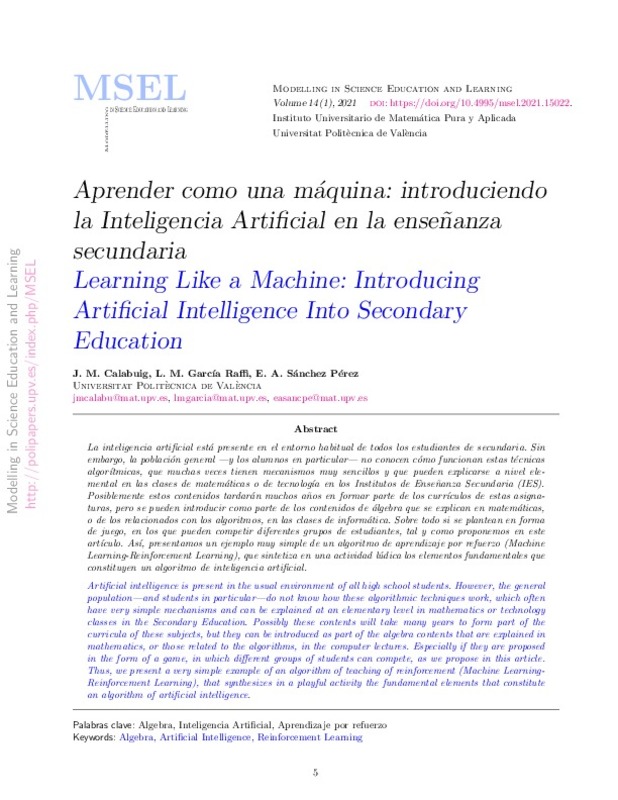JavaScript is disabled for your browser. Some features of this site may not work without it.
Buscar en RiuNet
Listar
Mi cuenta
Estadísticas
Ayuda RiuNet
Admin. UPV
Aprender como una máquina: introduciendo la Inteligencia Artificial en la enseñanza secundaria
Mostrar el registro sencillo del ítem
Ficheros en el ítem
| dc.contributor.author | Calabuig Rodriguez, Jose Manuel
|
es_ES |
| dc.contributor.author | García Raffi, Luis Miguel
|
es_ES |
| dc.contributor.author | Sánchez Pérez, Enrique Alfonso
|
es_ES |
| dc.date.accessioned | 2021-02-17T11:32:17Z | |
| dc.date.available | 2021-02-17T11:32:17Z | |
| dc.date.issued | 2021-01-27 | |
| dc.identifier.uri | http://hdl.handle.net/10251/161658 | |
| dc.description.abstract | [EN] Artificial intelligence is present in the usual environment of all high school students. However, the general population—and students in particular—do not know how these algorithmic techniques work, which often have very simple mechanisms and can be explained at an elementary level in mathematics or technology classes in the Secondary Education. Possibly these contents will take many years to form part of the curricula of these subjects, but they can be introduced as part of the algebra contents that are explained in mathematics, or those related to the algorithms, in the computer lectures. Especially if they are proposed in the form of a game, in which different groups of students can compete, as we propose in this article. Thus, we present a very simple example of an algorithm of teaching of reinforcement (Machine Learning-Reinforcement Learning), that synthesizes in a playful activity the fundamental elements that constitute an algorithm of artificial intelligence. | es_ES |
| dc.description.abstract | [ES] La inteligencia artificial está presente en el entorno habitual de todos los estudiantes de secundaria. Sin embargo, la población general -y los alumnos en particular- no conocen cómo funcionan estas técnicas algorítmicas, que muchas veces tienen mecanismos muy sencillos y que pueden explicarse a nivel elemental en las clases de matemáticas o de tecnología en los Institutos de Enseñanza Secundaria (IES). Posiblemente estos contenidos tardarán muchos años en formar parte de los currículos de estas asignaturas, pero se pueden introducir como parte de los contenidos de álgebra que se explican en matemáticas, o de los relacionados con los algoritmos, en las clases de informática. Sobre todo si se plantean en forma de juego, en los que pueden competir diferentes grupos de estudiantes, tal y como proponemos en este artículo. Así, presentamos un ejemplo muy simple de un algoritmo de aprendizaje por refuerzo (Machine Learning-Reinforcement Learning), que sintetiza en una actividad lúdica los elementos fundamentales que constituyen un algoritmo de inteligencia artificial. | es_ES |
| dc.language | Español | es_ES |
| dc.publisher | Universitat Politècnica de València | es_ES |
| dc.relation.ispartof | Modelling in Science Education and Learning | es_ES |
| dc.rights | Reconocimiento - No comercial (by-nc) | es_ES |
| dc.subject | Algebra | es_ES |
| dc.subject | Artificial Intelligence | es_ES |
| dc.subject | Reinforcement Learning | es_ES |
| dc.subject | Inteligencia Artificial | es_ES |
| dc.subject | Aprendizaje por refuerzo | es_ES |
| dc.title | Aprender como una máquina: introduciendo la Inteligencia Artificial en la enseñanza secundaria | es_ES |
| dc.title.alternative | Learning Like a Machine: Introducing Artificial Intelligence Into Secondary Education | es_ES |
| dc.type | Artículo | es_ES |
| dc.identifier.doi | 10.4995/msel.2021.15022 | |
| dc.rights.accessRights | Abierto | es_ES |
| dc.contributor.affiliation | Universitat Politècnica de València. Escuela Técnica Superior de Ingenieros de Caminos, Canales y Puertos - Escola Tècnica Superior d'Enginyers de Camins, Canals i Ports | es_ES |
| dc.contributor.affiliation | Universitat Politècnica de València. Escuela Técnica Superior de Ingenieros Industriales - Escola Tècnica Superior d'Enginyers Industrials | es_ES |
| dc.contributor.affiliation | Universitat Politècnica de València. Instituto Universitario de Matemática Pura y Aplicada - Institut Universitari de Matemàtica Pura i Aplicada | es_ES |
| dc.contributor.affiliation | Universitat Politècnica de València. Departamento de Matemática Aplicada - Departament de Matemàtica Aplicada | es_ES |
| dc.description.bibliographicCitation | Calabuig Rodriguez, JM.; García Raffi, LM.; Sánchez Pérez, EA. (2021). Aprender como una máquina: introduciendo la Inteligencia Artificial en la enseñanza secundaria. Modelling in Science Education and Learning. 14(1):5-14. https://doi.org/10.4995/msel.2021.15022 | es_ES |
| dc.description.accrualMethod | OJS | es_ES |
| dc.relation.publisherversion | https://doi.org/10.4995/msel.2021.15022 | es_ES |
| dc.description.upvformatpinicio | 5 | es_ES |
| dc.description.upvformatpfin | 14 | es_ES |
| dc.type.version | info:eu-repo/semantics/publishedVersion | es_ES |
| dc.description.volume | 14 | es_ES |
| dc.description.issue | 1 | es_ES |
| dc.identifier.eissn | 1988-3145 | |
| dc.relation.pasarela | OJS\15022 | es_ES |
| dc.description.references | Calvo J. (2020). Hay que enseñar Inteligencia Artificial desde los primeros niveles educativos. Educación 3.0 https://www.educaciontrespuntocero.com/entrevistas/ensenarinteligencia-artificial-niveles-educativos/ | es_ES |
| dc.description.references | Cobos M., R-Moreno M.D., Barrero D.F. (2020). R2P2: Un simulador robótico para la enseñanza de Inteligencia Artificial. Actas de las Jenui 5, 285-92. | es_ES |
| dc.description.references | Gross B. (1992). La inteligencia artificial y su aplicación en la enseñanza. Comunicación, lenguaje y educación 4(13), 73-80. https://doi.org/10.1080/02147033.1992.10821001 | es_ES |
| dc.description.references | Weng L. (2018). A (Long) Peek into Reinforcement Learning. https://lilianweng.github.io/lil-log/2018/02/19/a-long-peek-intoreinforcement-learning.html | es_ES |
| dc.description.references | Urretavizcaya M., Onaindía E. (2002). Docencia Universitaria de Inteligencia Artificial. Revista Iberoamericana de Inteligencia Artificial 6(17), 23-32. https://doi.org/10.4114/ia.v6i17.731 | es_ES |








